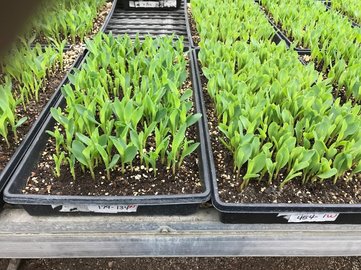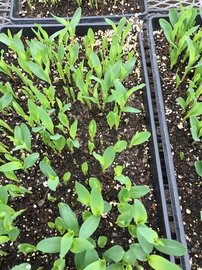|
Much of the Midwest corn belt is testing seed quality the hard way this year. Daytime temperatures in the mid 40°F for at least two days and about 3 inches of rain in Northern Illinois. Some fields were planted to corn 1-3 days before the cold, wet weather arrived. All the planted seed will imbibe, expanding the membrane-bound organelles within embryo cells, but no further metabolism will be activated at these low temperatures. Those individual seeds that are already weak will be further damaged from the expansion. Once the temperatures increase cellular metabolism will begin the repair process. Vigorous individuals will begin normal enzymatic digestion of stored starches and movement of these to mitochondria in the embryo, and normal cell growth will occur. Not all seed will have the same chance, however, some dying before it can push out the root or shoot from the kernel’s pericarp. Some may make it eventually but will be slower than the vigorous neighbor seed. Some will have torn first leaf when they emerge or may not have the strength to push to the soil surface.
PSR tests seed lots for percent emergence and uniformity of emergence in warm and cold tests. Four hundred seeds are planted into a greenhouse container with a special artificial soil mix, selected for uniform moisture distribution. Warm tests are placed on heated greenhouse benches with minimum of 70°F. Cold tests utilize the same soil mix but are placed in a cold room at 50°F for 7 days before moved to the greenhouse bench. Most seed samples that we test show the good uniform emergence as in one of the samples in the following photo and occasionally a sample has uneven emergence as in the other tray. The second photo shows poor uniformity in a sample. Not only is the total count of germinated seed low but some already have the 2nd leaf while others are emerging late, some with torn leaves. These seedlings are grown in a uniform environment, not devoid of microorganisms but without pathogens such as Pythium species. It is consistent with the view that despite being part of the same sample from one container, each seed can have a different seed quality at least at the time of testing. Comments are closed.
|
About Corn JournalThe purpose of this blog is to share perspectives of the biology of corn, its seed and diseases in a mix of technical and not so technical terms with all who are interested in this major crop. With more technical references to any of the topics easily available on the web with a search of key words, the blog will rarely cite references but will attempt to be accurate. Comments are welcome but will be screened before publishing. Comments and questions directed to the author by emails are encouraged.
Archives
December 2021
Categories
|


 RSS Feed
RSS Feed